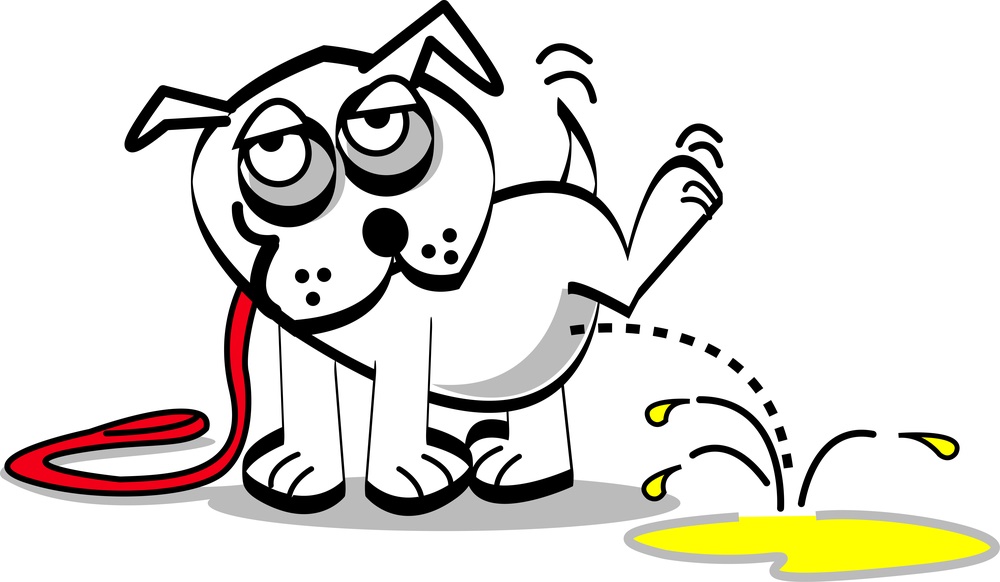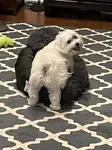Understanding dog marking...
And what to do about it
What is dog marking?
Dog marking is when your dog urinates as a way to protect his territory, to attract another dog, or when stressed or anxious. Now that you know what it is, let's tackle some of the most common questions about this dog marking activity.

Do only male dogs mark?
It's a common misconception that only male dogs mark. That's probably because it's easy to visualize a male dog lifting his leg on various objects - trees, bushes, fire hydrants, and unfortunately, even furniture or people. But females also mark to announce themselves to males and to mark their territory. Unspayed females are more likely to engage in this marking behavior, but that doesn't mean spayed Cotons won't mark.
What age does dog marking usually occur?
Male dogs usually start marking behavior when they mature at around 7 to 9 months. Neutered dogs are less likely to mark their territory, but it's not a 100% certainty that this behavior will cease. You will also have to train your dog so he knows what behaviors are acceptable and what behaviors are not. For female dogs, spaying will also reduce marking, since they often mark more often prior to going into heat.
What's the difference between marking and regular urinating?
If your dog is like Luc, he will urinate on every single tree or bush he passes - even when he's out of "juice". This is more of a marking issue since he really doesn't have to eliminate. I personally don't have a problem with this, since Luc knows that this is an "outside" behavior. When I want to go on a walk for exercise, Luc can tell by my gait and how I hold the leash that there will be no tree-hopping. It's a matter of training.
How do I stop my dog from marking inside the house?
First, make sure you know why your dog is urinating in the house. Does he truly have to go potty and hasn't been trained properly to let you know he has to go outside? If it's a training matter, that has to be addressed right away.
Is your housebroken dog suddenly peeing in your home? A medical issue may be the cause, so please check with your vet. Or have there been any new stressful situations for your dog that could be causing the marking behavior?
So, if your dog does have a problem with marking inside your home, what can you do about it?
How to stop your Coton from marking inside
- According to the Humane Society, marking can be reduced or eliminated altogether by spaying or neutering earlier rather than later. It's recommended to do this before your dog reaches sexual maturity (12-15 months).
- Once your dog has soiled an area in the house, it's imperative that it be cleaned up ASAP and thoroughly. If not, your dog will continually be attracted to that spot.
- If your dog's marking is a result of stress, eliminating the stressor is the answer. Whether it's separation anxiety, other animals, vet visits, or even loud noises, getting to the root cause is key to eliminating the fear based marking.
- Learn your dog's body language. Pay attention. Does he leave clues before he starts dog marking behavior?
- Keep your dog confined until the behavior is no longer an issue. You can use a crate or a gate, or keep him in a small room when left unattended.
- For severe dog marking behavior, you may have to consult with an expert like your vet. If your adult dog suddenly starts marking, there could be a physiological reason for it. If that fails, a dog trainer or behaviorist may be called for.
- Belly bands can be used for male dogs if supervision or confining your dog isn't an option. Female dogs can use doggy diapers until the problem is resolved.
- Never punish your dog for marking behavior, as this will likely exacerbate the problem by causing more stress. And if you catch your dog "in the act", don't yell or hit. Just calmly redirect his behavior. And as always, reward him when he urinates appropriately where he's supposed to (outside or on pee pads).
- See what our visitors have recommended for various house training and marking problems here.
Home | About Me | Contact Me | Privacy Policy |Disclosure
Copyright© 2008- All Rights Reserved








